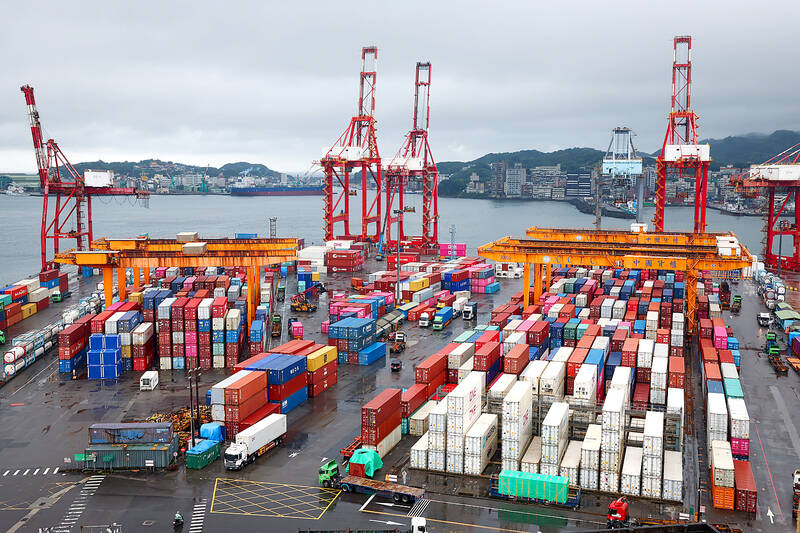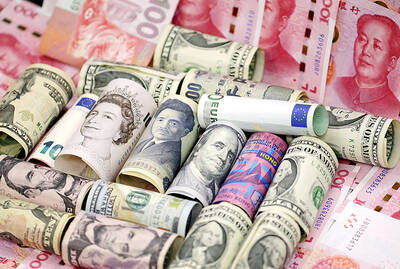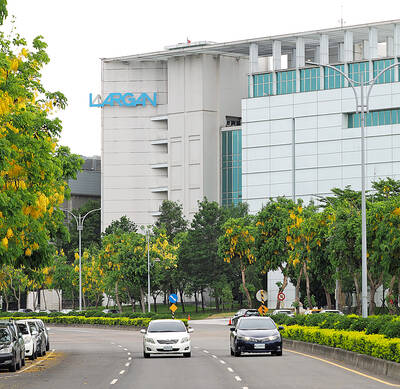Exports jumped 33.8 percent year-on-year last month to US$54.25 billion, the third-highest monthly level on record, as strong global demand for new-generation consumer electronics and artificial intelligence (AI) applications offset weakness in traditional industries, the Ministry of Finance said yesterday.
“The robust showing was helped by the arrival of the high season for technology products and insatiable demand for AI investment and applications,” Department of Statistics Director-General Beatrice Tsai (蔡美娜) told a media briefing.
Order visibility remains “bright and clear” through the end of the year, with shipments expected to expand 28 to 33 percent this month, buoyed by imports of capital equipment and related devices used for export production, Tsai said.

Photo: CNA
Exports in the first nine months of the year totaled US$452.68 billion, up 29.7 percent from the same period last year and 7.4 percentage points above the government’s forecast — signaling potential for an upward revision to Taiwan’s full-year GDP growth.
Electronic components continued to lead gains, with exports rising 25.6 percent to a record US$21.43 billion, driven by surging demand for advanced chips used in AI applications, and expanding need for cloud computing and data storage, Tsai said.
Shipments of information and communications technology as well as audiovisual products surged 86.9 percent to US$19.27 billion, led by orders for graphics cards and servers, she said.
The sector’s scale hit its highest September level, with the two categories accounting for about 75 percent of overall exports, she said.
In contrast, traditional industries saw only modest gains of 2.8 percent, or less than US$400 million in additional value, she said.
Exports of electrical machinery rose 5 percent, while basic metals and rubber products gained 1.7 percent and 8.6 percent respectively, Tsai said.
Shipments of transport equipment slipped 2.4 percent, she added.
“Taiwan has seen tech exports booming in the past two years, even as some sectors struggle with overcapacity,” Tsai said.
Exports to the US soared 51.6 percent to US$13.32 billion, while shipments to China, including Hong Kong, climbed 12.8 percent to US$15.86 billion, she said.
Exports to ASEAN members rose 34 percent to US$9.77 billion, underscoring the bloc’s growing role as a hub in supply chain realignment, she said.
Shipments to Mexico almost quadrupled to more than US$3.69 billion, making it Taiwan’s third-largest export market for the month, she said.
Imports rose 25.1 percent to US$41.86 billion — the third-highest monthly level on record — reflecting robust semiconductor equipment purchases and stocking tied to the export upcycle, the ministry said.
That left Taiwan with a trade surplus of US$12.4 billion, more than four times what it was a year earlier, it said.
With AI-related orders remaining solid, the ministry said it expects exports to stay strong for four straight quarters this year.
Shipments in the first 10 months are on track to exceed the full-year total for last year, Tsai said.

Taiwan’s foreign exchange reserves hit a record high at the end of last month, surpassing the US$600 billion mark for the first time, the central bank said yesterday. Last month, the country’s foreign exchange reserves rose US$5.51 billion from a month earlier to reach US$602.94 billion due to an increase in returns from the central bank’s portfolio management, the movement of other foreign currencies in the portfolio against the US dollar and the bank’s efforts to smooth the volatility of the New Taiwan dollar. Department of Foreign Exchange Director-General Eugene Tsai (蔡炯民)said a rate cut cycle launched by the US Federal Reserve

Handset camera lens maker Largan Precision Co (大立光) on Sunday reported a 6.71 percent year-on-year decline in revenue for the third quarter, despite revenue last month hitting the highest level in 11 months. Third-quarter revenue was NT$17.68 billion (US$581.2 million), compared with NT$18.95 billion a year earlier, the company said in a statement. The figure was in line with Yuanta Securities Investment Consulting Co’s (元大投顧) forecast of NT$17.9 billion, but missed the market consensus estimate of NT$18.97 billion. The third-quarter revenue was a 51.44 percent increase from NT$11.67 billion in the second quarter, as the quarter is usually the peak

The US government on Wednesday sanctioned more than two dozen companies in China, Turkey and the United Arab Emirates, including offshoots of a US chip firm, accusing the businesses of providing illicit support to Iran’s military or proxies. The US Department of Commerce included two subsidiaries of US-based chip distributor Arrow Electronics Inc (艾睿電子) on its so-called entity list published on the federal register for facilitating purchases by Iran’s proxies of US tech. Arrow spokesman John Hourigan said that the subsidiaries have been operating in full compliance with US export control regulations and his company is discussing with the US Bureau of

Pegatron Corp (和碩), a key assembler of Apple Inc’s iPhones, on Thursday reported a 12.3 percent year-on-year decline in revenue for last quarter to NT$257.86 billion (US$8.44 billion), but it expects revenue to improve in the second half on traditional holiday demand. The fourth quarter is usually the peak season for its communications products, a company official said on condition of anonymity. As Apple released its new iPhone 17 series early last month, sales in the communications segment rose sequentially last month, the official said. Shipments to Apple have been stable and in line with earlier expectations, they said. Pegatron shipped 2.4 million notebook